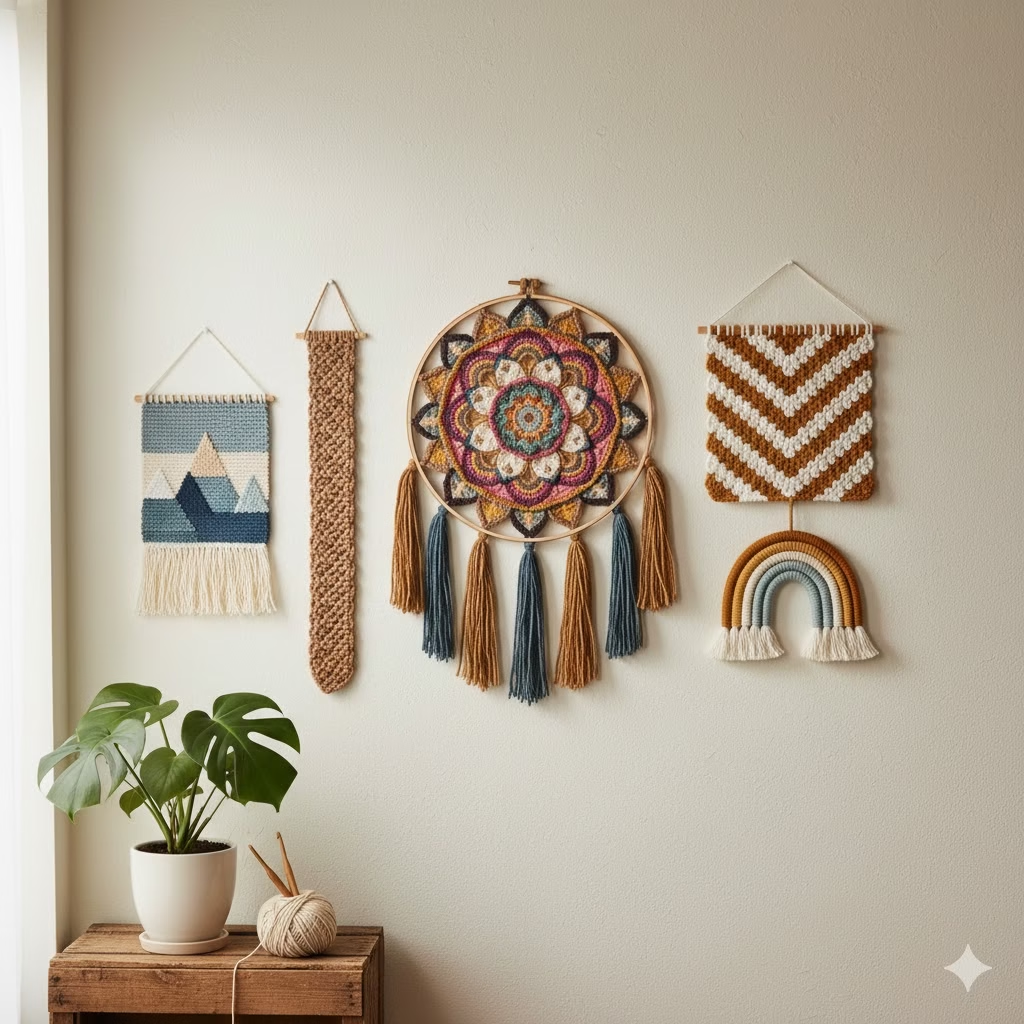
Hi there, I’m just like you—a fiber enthusiast who always has at least three projects going at once and a perpetually growing yarn stash. I started my journey with regular crochet and knitting, but when I discovered the unique woven texture of Tunisian Crochet, I was completely hooked (pun intended!). There’s a magic in this technique that produces stunning, boutique-quality fabrics, and I’m thrilled to share the essential Tunisian Crochet Stitches that have captured the entire crafting community’s heart. Let’s dive in and elevate your hook game!
Introduction: A New Craze in the Fiber World
For years, the fiber world was dominated by the classic elegance of knitting and the versatile simplicity of traditional crochet. But there’s a craft that combines the best of both, yielding a beautiful, dense, woven fabric that is suddenly taking over social media feeds and pattern libraries: Tunisian Crochet.
Also known as Afghan Crochet, this unique technique uses a longer hook (often with a flexible cable) to hold multiple loops on the hook, much like knitting, but with a single crochet hook. The fabric it creates is distinctive, often thicker, and less stretchy than traditional crochet, making it perfect for sturdy items, cozy blankets, and warm garments.
But what truly sets it apart are the extraordinary Tunisian Crochet Stitches you can create. They range from solid and knit-like to light and lacy, and a few key patterns have become the runaway stars of the moment. If you’ve been looking for an engaging new technique to tackle a stunning Tunisian Crochet Patterns project, you’ve come to the right place.
In this guide, we’ll explore the most popular Tunisian Crochet Stitches, provide step-by-step instructions on how to do them, include examples of projects, and share essential tips to master this addictive craft.

The Three Foundation Stitches: Your Essential Toolkit
Before we dive into the viral stitches, you must master the fundamental building blocks of Tunisian Crochet. Every subsequent pattern builds upon these basic techniques.
1. The Foundation Row (FR)
Every project begins with a foundation chain and an initial forward pass.
How to Do It:
- Chain (Ch): Start with a simple chain (Ch) of any desired number of stitches.
- Forward Pass (FP): Insert your hook into the back bump of the second chain from the hook, yarn over (YO), and pull up a loop. Leave the loop on the hook.
- Repeat this process in the back bump of every chain across the row. You should end the Forward Pass with the same number of loops on your hook as your initial chain count.
- Return Pass (RP): Do not turn your work. YO and pull through one loop (this creates your turning chain/edge).
- YO, and pull through two loops. Repeat the bracketed step (YO, and pull through two loops) until only one loop remains on your hook. This loop counts as the first stitch of your next row.
2. Tunisian Simple Stitch (TSS)
The TSS is the most common and arguably the most important stitch. It creates a beautiful, woven texture that resembles small square tiles.
How to Do It:
- Forward Pass (FP): Skip the first vertical bar (the loop on your hook counts as the first stitch).
- Insert your hook under the next vertical bar from right to left (or front to back).
- YO and pull up a loop. Leave the loop on the hook.
- Repeat Step 2 and 3 across the row until you reach the final stitch.
- Edge Stitch: For the last stitch, insert your hook under both the front and back loops of the last vertical bar to create a clean, non-curling edge. YO, pull up a loop.
- Return Pass (RP): Work the standard return pass (Ch 1, then YO, pull through 2 loops across).
Example Project: Washcloths, dishcloths, or a simple striped scarf.
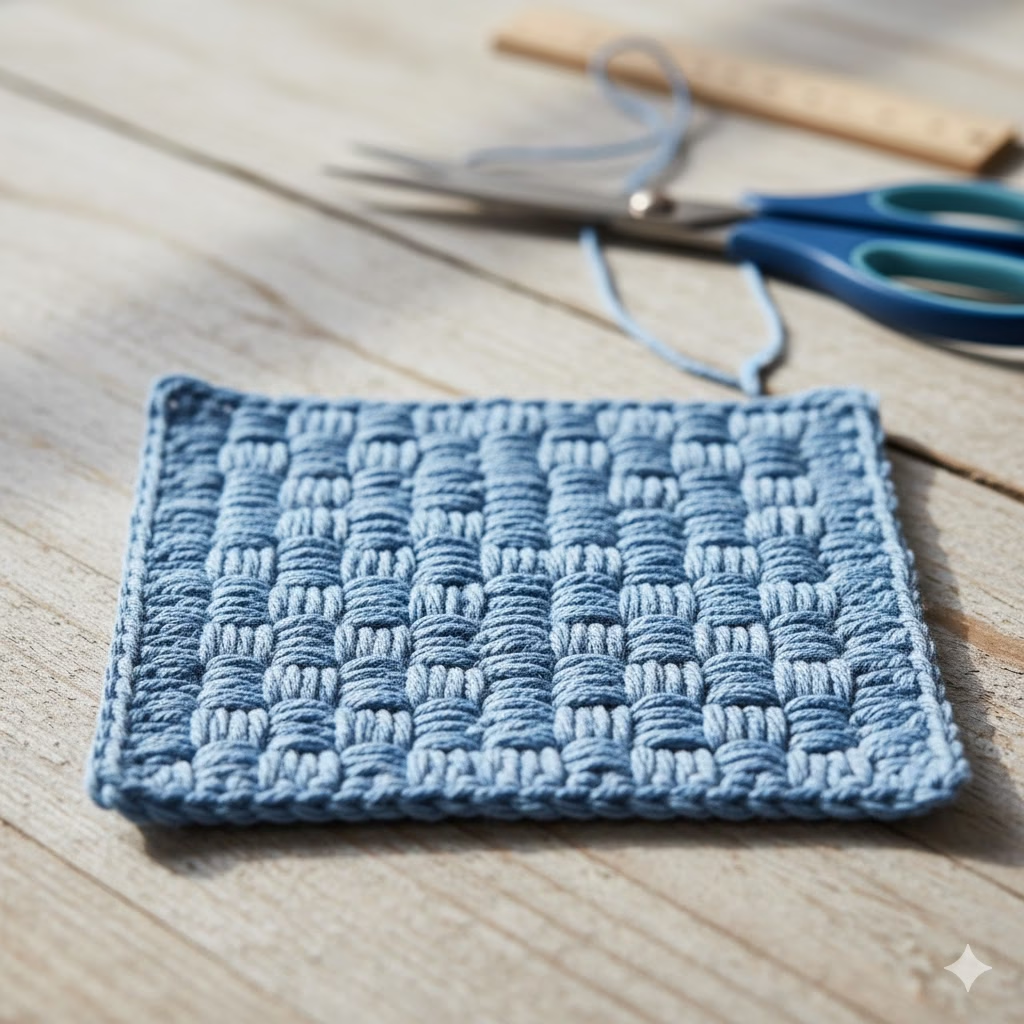
3. Tunisian Purl Stitch (TPS)
This is the stitch you use to counteract the notorious curl of Tunisian crochet fabric! It creates a series of horizontal bumps that closely resemble the purl stitch in knitting.
How to Do It:
- Forward Pass (FP): Skip the first vertical bar.
- Bring the yarn to the front of your work.
- Insert your hook under the next vertical bar (just like TSS).
- Bring the yarn to the back of your work.
- YO and pull up a loop. Leave the loop on the hook.
- Repeat Steps 2-5 across the row, remembering to work the final edge stitch under both loops.
- Return Pass (RP): Work the standard return pass.
Example Project: Ribbing for hats, cuffs, or an entire blanket with beautiful drape.
The Current Obsession: Viral Tunisian Crochet Stitches
These three stitches are currently trending in Tunisian Crochet Patterns for their unique texture, ease of learning, and stunning results.
1. The Tunisian Knit Stitch (TKS)
If you love the look of knitting but prefer using a crochet hook, this is your new favorite stitch. It creates a solid fabric that looks nearly identical to stockinette knitting. It’s also incredibly popular for warm accessories and garments.
How to Do It:
- Forward Pass (FP): Skip the first vertical bar.
- Instead of inserting your hook under the vertical bar (like TSS), you will insert your hook between the front and back vertical bars, going straight through the center of the stitch from front to back.
- YO and pull up a loop. Leave the loop on the hook.
- Repeat across the row, remembering to work the final edge stitch under both loops.
- Return Pass (RP): Work the standard return pass.
Examples: Beanies, cardigans, and throw blankets where a tight, knit-look fabric is desired.
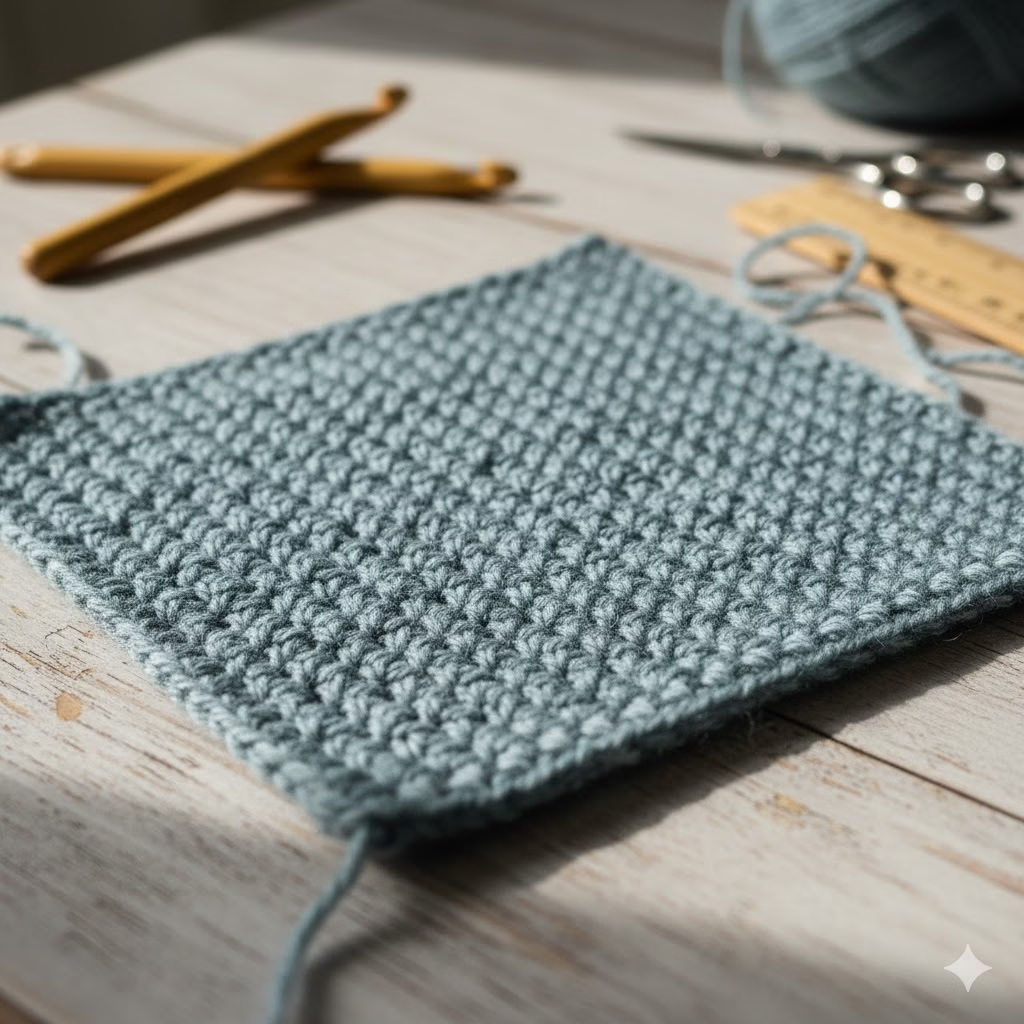
2. The Tunisian Honeycomb Stitch
This advanced-beginner stitch is pure texture magic. It creates a gorgeous, subtle grid or waffle-like fabric that is famous for having significantly less curl than many other stitches. It’s a two-row repeat that alternates the Tunisian Simple Stitch (TSS) and the Tunisian Purl Stitch (TPS).
How to Do It (2-Row Repeat):
- Row 1 (FP): TSS in the next vertical bar, then TPS in the following vertical bar. Repeat from the beginning of the sentence across the row, ending with a TSS (if starting with a TSS). Work the final edge stitch under both loops.
- Row 1 (RP): Work the standard return pass.
- Row 2 (FP) – Switching the pattern: TPS in the next vertical bar (where you worked a TSS in the previous row), then TSS in the following vertical bar (where you worked a TPS in the previous row). Repeat from the beginning of the sentence across, ensuring you alternate the stitches from the row below. Work the final edge stitch under both loops.
- Row 2 (RP): Work the standard return pass.
- Repeat Rows 1 and 2 for the Honeycomb Pattern.
Examples: Scarves, cowls, cushion covers, and structured bags.

3. The Tunisian Smock Stitch
The Tunisian Smock Stitch is an eye-catching, highly textured stitch that creates a stunning, woven effect reminiscent of diamond shapes or basketry. It’s a wonderful stitch for heavier-weight yarns and structured projects.
How to Do It (Forward Pass, 2-Row Repeat):
- Row 1 (FP): Skip the first vertical bar. Work a standard TSS in the next stitch. Then, for the remainder of the row, you will be working Tunisian Simple Stitch 2 Together (TSS2tog).
- TSS2tog: Insert your hook under the next two vertical bars simultaneously, YO, and pull up a loop. Leave the loop on the hook.
- Repeat TSS2tog across the row. The row will end with one vertical bar remaining. Work the final edge stitch in the last vertical bar under both loops.
- Row 1 (RP): Work the standard return pass.
- Row 2 (FP) – Offset Row: Skip the first vertical bar. Work the next stitch as a TSS. This places the single TSS in the center of the two stitches you worked together in the row below.
- Repeat TSS2tog across the row. Work the final edge stitch.
- Row 2 (RP): Work the standard return pass.
- Repeat Rows 1 and 2 for the Smock Pattern.
Examples: Textured blankets, rugs, and thick, warm jackets.
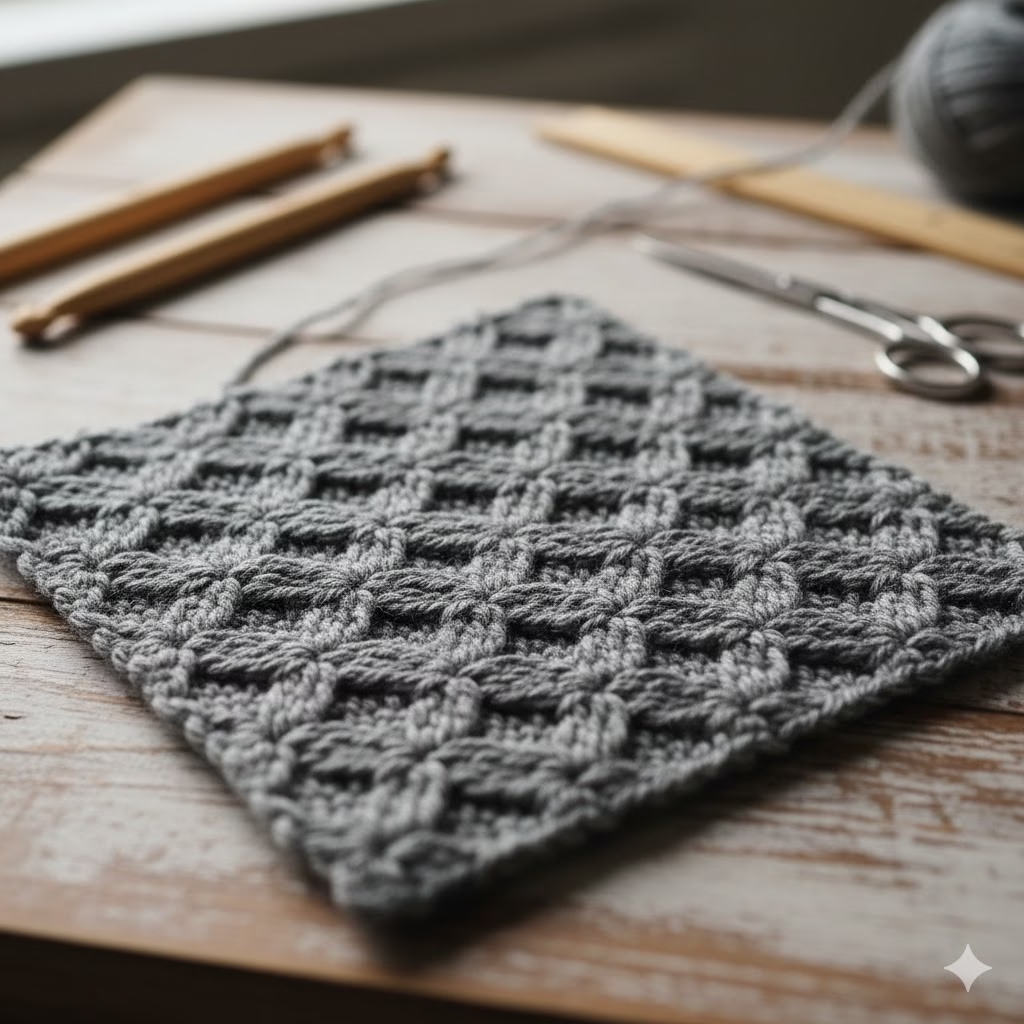
Mastering Tunisian Crochet: Tools & Tips
To truly master these popular Tunisian Crochet Stitches and tackle ambitious Tunisian Crochet Patterns, you’ll need the right equipment and a few pro tips.
The Right Tools
- The Hook: You need a specialized Tunisian hook. These are significantly longer than standard crochet hooks, allowing you to hold an entire row of loops. For larger projects, a hook with a flexible cable attached is essential.
- The Size: The general rule of thumb is to use a hook that is at least 2-3 sizes larger than the size recommended on your yarn label. This is crucial for counteracting the natural density and stiffness of the fabric and helping to minimize the frustrating curl.

The Curl Conundrum: How to Beat It
The most common frustration with Tunisian Crochet is the fabric’s tendency to curl aggressively. This is due to the structure of the Forward Pass—it uses up more yarn than the Return Pass, pulling the fabric inward.
Expert Tips to Minimize Curl:
- Use a Larger Hook: As mentioned, this is the number one trick.
- Use a Curl-Reducing Stitch: Patterns that incorporate the Tunisian Purl Stitch (like the Honeycomb Stitch or a simple Ribbing) will curl significantly less than all-Simple Stitch projects.
- Add a Border: Once your project is complete, add a simple border of single crochet (UK double crochet) stitches around the edge. This provides weight and structure, flattening the edges.
- Block Aggressively: Blocking is essential for all Tunisian Crochet items. Wet or steam-block your finished piece and pin it aggressively to the desired dimensions to permanently set the stitches and remove the curl.

Why the Obsession? The Benefits of Tunisian Crochet
Why are so many crafters dropping their needles and standard hooks to pick up this technique?
| Feature | Tunisian Crochet | Traditional Crochet |
| Fabric Look | Dense, woven, often knit-like (especially TKS). | Varied, from open/lacy to dense, but with distinct “V” stitches. |
| Fabric Drape | Less stretchy horizontally, often heavier and more structured. | Generally more stretchy and flowy. |
| Stitch Visibility | Excellent for showcasing complex colourwork (like fair isle or plaid). | Good, but colourwork texture is often less defined. |
| Error Fixing | Easier to ‘frog’ (unravel) back to a previous row without losing stitches, similar to a dropped knit stitch. | Generally easier to ‘tink’ (un-crochet stitch by stitch). |
| Finished Edge | A natural, neat edge is created by the technique, making borders optional. | Edges often require a separate finishing row for a polished look. |
The ability of Tunisian Crochet to mimic the polished, woven look of knitting while retaining the speed and ease of using a single hook is what makes it such a breakout star in the fiber arts community. Its unique structure means you can create Tunisian Crochet Patterns for garments that feel substantial, blankets that are extra warm, and accessories that have beautiful, defined texture.

Inspiration: Projects for Every Stitch
Ready to get started? Here are some simple project ideas for your new favorite Tunisian Crochet Stitches:
- For the Beginner: A simple Tunisian Simple Stitch (TSS) scarf. It’s the perfect way to practice your tension and get comfortable with the Forward and Return Passes.
- For the Cozy Crafter: A baby blanket using the Tunisian Knit Stitch (TKS). The dense fabric is incredibly warm, and the knit look makes it a stunning gift.
- For the Textured Lover: A sophisticated two-tone cushion cover using the Tunisian Honeycomb Stitch in contrasting colours for maximum visual impact.
- For the Garment Maker: A warm winter cowl or hat using the Tunisian Smock Stitch. The fabric’s thickness makes it ideal for cold weather accessories.
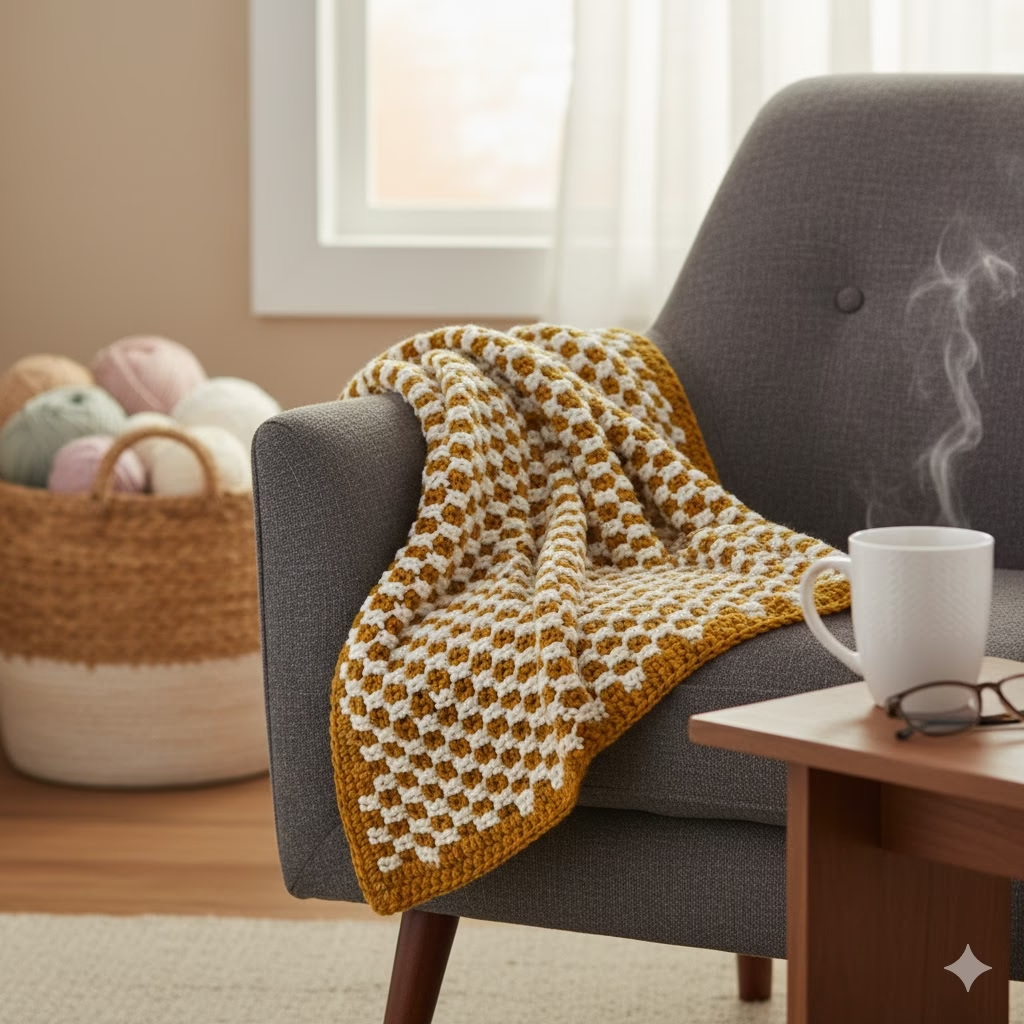
Frequently Asked Questions (FAQ)
Q1: What kind of hook do I need for Tunisian Crochet?
A: You will need a Tunisian crochet hook, which is longer than a standard hook, usually 10 to 14 inches. For projects wider than a scarf (like blankets or shawls), you will need a hook with a flexible cable attached to hold all the loops.
Q2: Does Tunisian Crochet use more yarn than regular crochet or knitting?
A: Yes, generally, Tunisian Crochet uses more yarn than traditional crochet or knitting for a project of the same size. This is due to the unique construction where the yarn is worked in two passes, creating a denser fabric. Plan for slightly more yarn than you would for a standard crochet project.
Q3: How do I read a Tunisian Crochet pattern?
A: Tunisian Crochet Patterns are unique because they are split into a Forward Pass (FP), where you pick up loops and load them onto the hook, and a Return Pass (RP), where you work the loops off. The instructions will specify the stitch for the FP, and the RP is almost always the same (chain 1, then YO, pull through 2 loops across).
Q4: How do I finish a Tunisian Crochet project?
A: To finish, you must bind off all the loops on the last Forward Pass using a slip stitch bind off. Insert your hook as instructed by the last stitch, YO, and pull through the loop on the work and the loop on the hook (a slip stitch). This flattens the final edge and locks the stitches. You should then block the finished item.
References
- TL Yarn Crafts – How to Crochet the Tunisian Crochet Honeycomb Stitch
- The Craftsy Blog – Tunisian Crochet vs. Traditional Crochet
- Crochet Kim – How to Tunisian Crochet: Extensive Beginners Guide
Recent Posts
